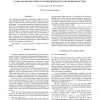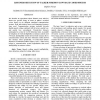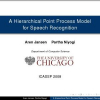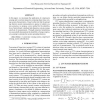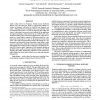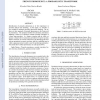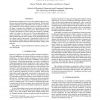ICASSP
2008
IEEE
14 years 9 months ago
2008
IEEE
ICASSP
2008
IEEE
14 years 9 months ago
2008
IEEE
One commonly used approach for language recognition is to convert the input speech into a sequence of tokens such as words or phones and then to use these token sequences to deter...
ICASSP
2008
IEEE
14 years 9 months ago
2008
IEEE
We describe an experiment where listeners were asked to detect two specific forms of stress in talkers’ recorded voices heard via six different simulated communication systems. ...
ICASSP
2008
IEEE
14 years 9 months ago
2008
IEEE
ICASSP
2008
IEEE
14 years 9 months ago
2008
IEEE
We present theoretical results pertaining to the ability of ℓp minimization to recover sparse and compressible signals from incomplete and noisy measurements. In particular, we ...
ICASSP
2008
IEEE
14 years 9 months ago
2008
IEEE
In this paper, we investigate the application of compressive sensing and waveform design for estimating linear time-varying system characteristics. Based on the fact that the spre...
ICASSP
2008
IEEE
14 years 9 months ago
2008
IEEE
Audio coding based on Frequency Domain Linear Prediction (FDLP) uses auto-regressive model to approximate Hilbert envelopes in frequency sub-bands for relatively long temporal seg...
ICASSP
2008
IEEE
14 years 9 months ago
2008
IEEE
Identification of prosodic phenomena is of first importance in prosodic analysis and modeling. In this paper, we introduce a new method for automatic prosodic phenomena labellin...
ICASSP
2008
IEEE
14 years 9 months ago
2008
IEEE
Recently, we successfully developed and reported a new unsupervised online adaptation technique, which jointly compensates for additive and convolutive distortions with vector Tay...
ICASSP
2008
IEEE
14 years 9 months ago
2008
IEEE
Missing data techniques have been recently applied to speaker recognition to increase performance in noisy environments. The drawback of these techniques is the vulnerability of t...

